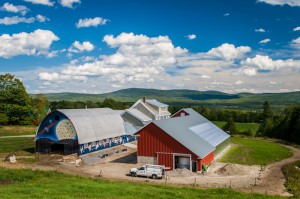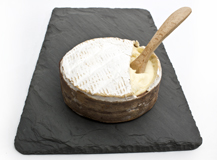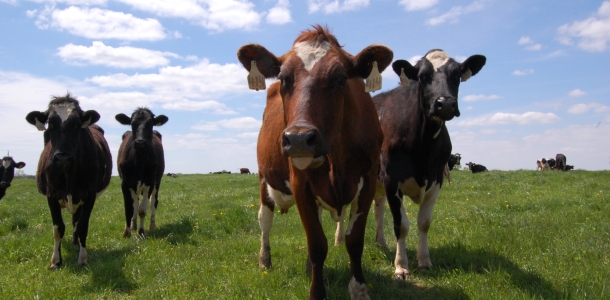Like most industrialized food products, Cheese gets a bad rap for not being the most earth friendly. With Earth day imminently approaching, I find myself thinking about cheese, how it’s produced, and the effect its production has on our environment.
Ultimately the environmental issues that surround cheese are based on its very low yield ratio. It takes a lot of milk to produce cheese! (About 10 gallons of milk for one pound of cheese.) The current model for mass dairy production maximizes yield, with little concern for the environmental effects. I do think that it is important differentiate industrial cheese and what we have behind the case at Murray’s. Most of our cheese comes from smaller farmers, who take the time to care for their milk, and while profit is intended it is achieved with good farming practices in mind. In fact many cheese producers believe that what they are doing is not making cheese or milk, rather growing grass, after all it is the grass that ultimately becomes cheese. Farmers are also finding new ways to keep their systems more closed and efficient. This means turning waste into profit.

Jasper Hill Creamery, cheesemakers who we have worked with for years, are pioneers in the field of closed system dairy farms. They have implemented a waste treatment facility on their farm that they call the “Green Machine.” This converted barn allows the farm to process and reuse waste from both cows and cheese making. Whey, the liquid byproduct of cheese making, is treated and then used to irrigate land, while manure is processed for fertilizing, and methane is harvested for heating. By creating this closed system, and eliminating as much waste as possible, Jasper Hill can make great cheese, while reducing their negative impact to the environment.

These efforts aren’t just good for the planet, they’re good for your taste buds too! The truth is, the correlation between flavor and responsible farming is strong. When a cheese is well made and full of deep nuance, it is often the result of well-fed cows and well-farmed land. If you are looking for something earth friendly, the Mongers at Murray’s should have no problem pointing you in the right direction. In fact, these are probably their favorite cheeses!


The result is a cheese which hardly even resembles a Chaource. It is a slow ripened lactic curd. This is not a double or triple crème cheese as is sometimes thought. Seasonal variations in the milk result in variations on the surface and flavor of the cheese. We named Constant Bliss after a revolutionary war scout killed in Greensboro by native Americans in 1781. He was guarding the Bayley Hazen Military Road with his compatriot Moses Sleeper, who died with him.
I have just started cheesemaking here in Tanzania – obviously very small-scale! We get our milk from our neighbours who use a biogas stove – fuelled by their cows. We use the whey in all kinds of cooking and it’s great for our pigs. And we’ve made a clay cooler to store maturing cheese in!
WOW! That sounds awesome. Keep us up-to-date on your progress!
Vermont has seen a drastic reduction in viable dairy farms in past years — the price farmers get for their milk barely pays overhead and production costs. The Kehlers saw that they could create a network of dairy farmers and cheese makers in their small Vermont community, which would renew industry and create jobs for the region.